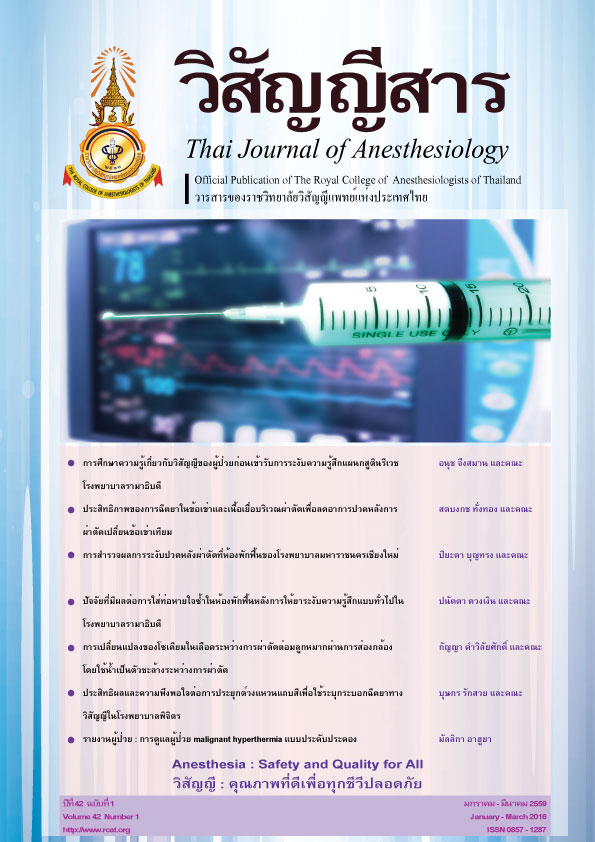Risk factors of reintubation in post anesthetic care unit after general anesthesia in Ramathibodi Hospital
Main Article Content
Abstract
Background: Postoperative reintubation is a high-risk procedure in the critically ill patients and it is a significant indicator for anesthetic services. Minimizing the incidence of reintubation in post anesthetic care unit (PACU) is the goal for quality improvement in anesthetic care.
Objectives: To study the incidence of reintubation in PACU and the risk factors of reintubation.
Methods: The retrospective study was conducted in 35,216 patients underwent surgery under general anesthesia with endotracheal tube in Ramathibodi Hospital from January 2010 to December 2013.
Results: The incidence of reintubation in PACU after general anesthesia (n=35) was 9.9: 10,000 patients. The incidences of factors associated with patients, surgery and anesthesia were 37.1%, 20% and 42.9%, respectively. There was 71.4% of patients with ASA physical status (PS) 3-4. The factors of anesthetic care that led to reintubation was 42.9%. These factors include the effect of remaining muscle relaxant, anesthetic drugs or opioid received during perioperative period. The incidence of reintubation was found mainly beyond the office hours (4-6 PM). The highest incidence was 1.1 patients: 10,000 working hours. The risk of reintubation in patients aged > 65 years was 2.7 times higher than the risk of age of 16-65 years (OR=2.7, p=0.005). The risk of intubation in the patients with ASA PS 3-4 was higher than the patients with ASA PS 1-2 (OR=2.8, p=0.006).
Conclusion: The risk factors of reintubation in PACU for patients underwent surgery and received general anesthesia with endotracheal tube were age > 65 years, ASA PS 3-4, remaining effect of anesthetic drug and service beyond the office hours. These results could be used to improve the anesthetic care services.
ปัจจัยที่มีผลต่อการใส่ท่อหายใจซ้ำในห้องพักฟื้นหลังการให้ยาระงับความรู้สึกแบบทั่วไป
ในโรงพยาบาลรามาธิบดี
บทนำ: การใส่ท่อหายใจซ้ำหลังผ่าตัดเป็นหัตถการที่มีความเสี่ยงสูงในผู้ป่วยวิกฤต ซึ่งอาจก่อให้เกิดภาวะ แทรกซ้อนตามมามากกว่าการใส่ท่อหายใจในครั้งแรก และมีความสำคัญสำหรับงานบริการทางด้านวิสัญญี การลดอุบัติการณ์การใส่ท่อหายใจซ้ำในห้องพักฟื้นถือเป็นเป้าหมายที่สำคัญในการพัฒนาคุณภาพการบริการ ทางวิสัญญี
วัตถุประสงค์: เพื่อศึกษาอุบัติการณ์การใส่ท่อหายใจซ้ำในห้องพักฟื้นและปัจจัยที่มีผลต่อการใส่ ท่อหายใจซ้ำ
วิธีการศึกษา: เป็นการศึกษาเชิงพรรณนาแบบย้อนหลังในผู้ป่วยทุกคนที่เข้ารับการผ่าตัดและได้ รับการระงับความรู้สึกแบบทั่วไปที่ต้องใส่ท่อหายใจ ในโรงพยาบาลรามาธิบดี ตั้งแต่เดือนมกราคม 2553 ถึง เดือนธันวาคม 2555 เป็นจำนวน 35,216 คน
ผลการศึกษา: อุบัติการณ์การใส่ท่อหายใจซ้ำในห้องพักฟื้นหลัง การให้ยาระงับความรู้สึกแบบทั่วไป คิดเป็น 9.9 ต่อผู้ป่วย 10,000 คน ปัจจัยที่เป็นสาเหตุของการใส่ท่อหายใจซ้ำ ในห้องพักฟื้นหลังผ่าตัดมาจากปัจจัยทางด้านผู้ป่วย ด้านการผ่าตัด และด้านวิสัญญี คิดเป็นร้อยละ 37.1 ร้อยละ 20.0 และร้อยละ 42.9 ตามลำดับ โดยผู้ป่วยที่ใส่ท่อหายใจซ้ำ ร้อยละ 71.4 มี ASA physical status (PS) อยู่ในระดับ 3-4 ปัจจัยทางวิสัญญีมีผลทำให้เกิดอุบัติการณ์การใส่ท่อหายใจซ้ำ คิดเป็นร้อยละ 42. สาเหตุจาก ฤทธิ์ของยาหย่อนกล้ามเนื้อ ยาระงับความรู้สึกที่หลงเหลืออยู่หรือยาระงับปวดที่ได้รับระหว่างการผ่าตัด ช่วง เวลาที่เกิดอุบัติการณ์เกิดในช่วงนอกเวลาราชการ ระหว่างเวลา 16.00-18.00 น. พบอุบัติการณ์ต่อชั่วโมงสูงสุดที่ 1.1 คน ต่อผู้ป่วย 10,000 ชั่วโมงการทำงาน ผู้ป่วยที่มีอายุมากกว่า 65 ปีมีความเสี่ยงต่อการใส่ท่อหายใจซ้ำ 2.7 เท่า เมื่อเทียบกับผู้ป่วยที่มีอายุ 16-65 ปี (OR=2.73, p=0.005) และพบ ASA PS 3-4 มีความเสี่ยงต่อการใส่ ท่อหายใจซ้ำได้ 2.8 เท่า เมื่อเทียบกับ ASA PS 1-2 (OR=2.782, p=0.006)
สรุป: ปัจจัยที่มีผลต่อการใส่ท่อหายใจ ซ้ำในห้องพักฟื้นหลังการผ่าตัดและได้รับการระงับความรู้สึกแบบทั่วไปที่ต้องใส่ท่อหายใจ ได้แก่ ผู้ป่วยที่มีอายุ มากกว่า 65 ปี ผู้ป่วยที่มี ASA PS 3-4 ฤทธิ์ของยาระงับความรู้สึกที่หลงเหลือ และการให้ยาระงับความรู้สึก ที่อยู่นอกเวลาทำการ ผลที่ได้จากการศึกษานี้จะเป็นประโยชน์ในการพัฒนาคุณภาพการบริการทางวิสัญญี


